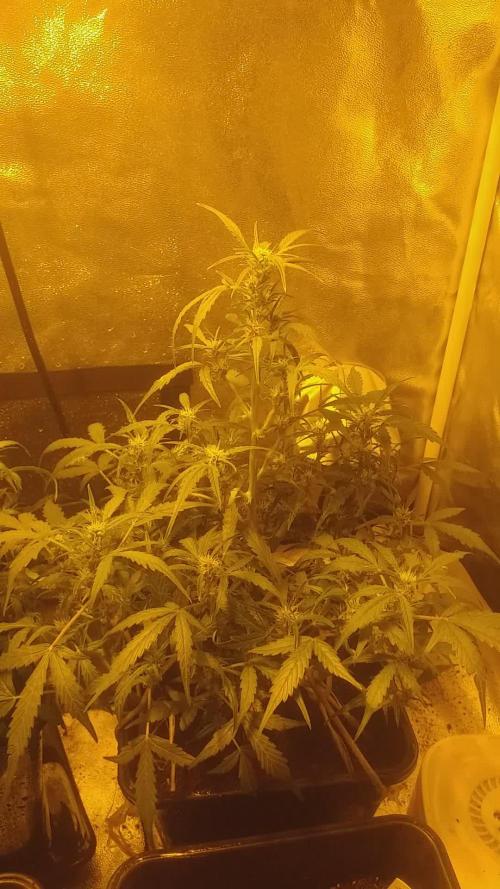The Grow Awards 2026 🏆 



































Likes
Comments
Share


@Pot_Portraits
Follow
Hey guys, update week 2 this week I decided to do a video update to change it up, I also didnt take the plants out of the plant this week just gave water.
They are all happy and grow at a nice rate, still no fertilizer just water in Sonnenerde living soil, even though the size of them compared to the pot size makes me worry a bit.
Lets see what the next week has in store as we continue this journey together.
I have to say I like these genetics a lot, all making nice trichomes and developing a beautiful aroma, solid plants, not one of the 4 doing funky things.
Solid genetics !
Likes
33
Share


@Ema26
Follow
Day 92: what’s happening guys! Week 14 is here. Temps have been okay and humidity has been okay. I’ve got the 400w hps set up and it’s dropped temps slightly and slightly raised humidity which is what I wanted. In my opinion she’s looking ready for the chop! I’m seeing plenty of cloudy trichomes and a few ambers and I’m going for less of a couch lock so I’m thinking around now she is ready. I started plain water 6 days ago and she’s recieved 2L,1L and then 1L again today. All leaves have started yellowing, I imagine this is the plant pulling the nitrogen from the leaves as there’s none at the roots. How much longer does she need to be fed plain water for before she is ready for the chop? Thanks! Stay safe and happy growing✌️🌱🍁
End of the day edit: I decided to harvest the majority of her. The bottoms just a bit under developed so I’ll leave it going a bit longer. After chopping and taking photos out of the hps light the nugs are looking a tinge purple although I can’t see it as strong with my eyes. Hopefully I’ll get a wet weight later so I can add it to the diary later on. Temp is around 24c and humidity is 45-55. How does that sound? I’ve got extractor at the top and a fan at the bottom. We’ll see how long it takes to dry, hoping to go for atleast 5 days. With the virus going around I’m really making use of what I have at home so hopefully the climate will hold up🤞 any tips and advice about drying and curing etc is hugely appreciated🙏 I’ll be back with the harvest update once she’s dried out✌️many thanks happy growing!🍁🌱
She weighed in wet at 110 grams. Any ideas what she’ll weigh dry? I’m guessing an ounce if I’m lucky.
Likes
32
Share


@jwh_hero
Follow
VEGETATION week 5 (CBD on the left, GС on the right)
Day 29: changed the solution, cut off the first floor of both plants, ppm-1237
Day 31: continue LST, ppm-1716
Day 33: ppm-1716
Day 35: ppm-1716
Likes
11
Share


@Beedog
Follow
Good weed will come back with full harvest weight when it’s all fully dry total weight 1650g and a plant that went to complete shit that had about 6oz on it added to the trim to be made into something what ever she decides so over all a good harvest if I had another two weeks and not a massive heat wave in middle of flower i reckon I would of touched two keys
Likes
10
Share


@Hazehouse
Follow
Lower leaves died and so I needed to defoliate plants grew quite a bit in this stage and preflowering shows they are girls temp dropped outside finally and so dehumidifier is constantly running. With a nice 78 degrees 50 rh
Likes
17
Share


@Naujas
Follow
it's amazing, this growth looks much better than my first attempt, my decision was to put a smaller pot and change the light - the girl really liked it, FastBuds goriilla cookies with a small space manage perfectly:).
Likes
10
Share


@4F1M6
Follow
Stretch is done and flowers are piling on now! I treated with lost coast as a preventative. I kept the feed the same but it will be altered end of grow week. Canopy is getting hella full can't wait to watch these colas stack on. Until next update. Happy growing and stay lit fam.
Likes
11
Share


@4Twentygrows
Follow
Will update more once cured. Very pleased with this muster strain and have already purchase two more mix packs and will be planting more soon.
Likes
129
Share


@Ju_Bps
Follow
Hello growmies 👩🌾👨🌾🌲🌲,
👋 The flowering is in progress
Week was a bit a disaster...
I've lost almost all my leaves in few days, more and more Yellow really fast, like a senesence.
The friend @trimva , told me was maybe locked by salt accumulated, so I've tried to did a flush.
I don't really understand what's happened with this one, after the flush, look under control 🤞🤞
We'll see next week how will progress...
💧 Give water each 2/3 days.
1,5l Water + Flash Cleaner
PH @6
💡Mars Hydro - SP 3000
100% 47 cm.
🔥 Thanks community for follow, likes, comments, always a pleasure 👩🌾👨🌾💚🌲.
Mars Hydro - SP 3000 💡💡
https://www.mars-hydro.com/sp-3000-samsung-lm301b-greenhouse-led-grow-light
Zamnesia - Frosted Guava Auto🌲🌲
Discount code -20% with GROWITGD code 🔥🔥
https://www.zamnesia.com/7679-zamnesia-seeds-frosted-guava-automatic.html
Processing
Likes
20
Share


@Divs_darkroom
Follow
I turned off one of the mars panels. My garden isn't big enough to need that much light. So I just have the hlg65 and 1 mars panel going. This girl drinks like crazy. And she is quick to droop her leaves to tell you she's thirsty. Grow a lot in the past week. This will be the biggest autoflower I have grown so far.
Likes
10
Share


@barlobruz
Follow
08/30/2021
- Noticing more gnats than usual. Could be overwatering, anaerobic soil conditions, or both.
- Going to set up fly traps, starve both the plant and the gnats of water for about a week.
- Will observe any stress responses due to an extended dry period.
Likes
5
Share


@LeedsCityFarmz
Follow
So this week flushing began. Flushed with water pH 6.0 EC 0.1, I won't harvest the plants untill the run off EC is the same as the Input EC. Temps also brought down to preserve Terps as much as possible. Serious smell coming from both strains, Buds are somehow getting even frostier. Can not wait to harvest these two strains!
Likes
Comments
Share


@Lachlan
Follow
Not hyped on the weight but some quality buds! It's my fault they stayed small anyways due to my grow room isn't great
Did 12h of darkness and a full 3 weeks flush
Likes
12
Share


@artems
Follow
Thats a new experience for me. To grow and share the result. Im really like it. It's helpful, inspiring and have a great community! Thank for support, keep in touch for new grows!
Likes
223
Share


@Tropicannibis_Todd
Follow
💩Holy Crap We Are Back At It And Loving It💩
Growmies we are at DAY 21 and she's just killing💀it👌
So Shit , I gave them just a tad to much nutes 👈 But I have since fixed it
So I'm starting to pull her over and do some low stress training 🙃
Lights being readjusted and chart updated .........👍rain water to be used entire growth👈
👉I used NutriNPK for nutrients for my grows and welcome anyone to give them a try .👈
👉 www.nutrinpk.com 👈
NutriNPK Cal MAG 14-0-14
NutriNPK Grow 28-14-14
NutriNPK Bloom 8-20-30
NutriNPK Bloom Booster 0-52-34
I GOT MULTIPLE DIARIES ON THE GO 😱 please check them out 😎
👉THANKS FOR TAKING THE TIME TO GO OVER MY DIARIES 👈
Processing
Likes
13
Share


@Agentweed
Follow
So 28 days in flower everything is going good plants at 3 foot I don't think she will grow in height was hoping she would tho any suggestions would be helpful guys and girls
Likes
17
Share


@Lazuli
Follow
This plant was grown in pure coco with 30% perlite, one watering a day untill runoff, at the mid flowering i water once every 12hours. She does get very bushy and puts on all the weight at the end of flowering so i was a bit worried first but she blew up
Likes
61
Share


@WhiteEdge
Follow
30.04.2024
Continue into week 9
Clean nutrient tank for the last time...This is last week of flowering for almost all girls.
Electrical Conductivity (EC): 0.8 for this week..
Purple Lemonade: First pheno is insane! Shape, size ,color, bud hardness, appearance, frostiness' all attributes to become photo model!
Beautiful and high odor in the room!
Lighting Parameters: PAR Map: Maximum PPFD is 800, minimum PPFD is 550.
VPD: Ranges from -0.1-1.1
Daytime Temperature (DT): 23-24°C.
Nighttime Temperature (NT): 19-20°C.
Leaf Temperature: 21-22°C.
Light Distance: 45-55 cm from the plants.
CO2 Levels: 700+ ppm.
HLG Scorpion Diablo: Set at 60%, positioned at a 45-55 cm distance.
Girls drink less water, so for this week and till the end of flowering new misting timing's
Daytime: ON for 50 seconds, followed by 30 minutes OFF.
Nighttime: OFF for 50 seconds, followed by 45 minutes OFF.
Nutrient Tank (NT):
pH: Maintained between 5.80 and 6.00. Stable PH, small drifting up and downs
EC: 0.87
Temperature: 19-21°C
















